Beko WTE 5411 B0 User manual [EN,BG,AR]

Washing Machine
User Manual
Пральна машина
Посібник користувача
ةلاسغلا
مدختسملا ليلد
WTE 5411 B0
EN / BG / AR
Document Number : 2820525898_EN / 03-06-20.(11:14)

This product was manufactured using the latest technology in environmentally friendly conditions.

1 General safety instructions
This section includes security instructions which may help prevent the injuries and material damage risks. All kinds of warranties shall be invalid if these instructions are not observed.
1.1 Life and property safety
u Never place the product on a carpet-covered floor. Electrical parts will get overheated since air cannot circulate from under the device. This will cause problems with your product.
u Unplug the product if it is not in use.
u Always have the installation and repairing procedures carried out by the Authorised Service Agent. The manufacturer shall not be held liable for damages that may arise from procedures carried out by unauthorised persons.
u The water supply and draining hoses must be securely fastened and remain undamaged. Otherwise, water leak may occur.
u While there is still water inside the product, never open the loading door or remove the filter. Otherwise, risk of flooding and injury from hot water will occur.
u Do not force open the locked loading door. Door can be opened a few minutes after the washing cycle ends. In case of forcing the loading door to open, the door and the lock mechanism may get damaged.
u Use detergents, softeners and supplements suitable for automatic washing machines only.
u Follow the instructions on the label of textiles and the detergent package.
1.2 Children's safety
u This product can be used by the children who are at the age of 8 and over and the people whose physical, sensory or mental skills are not fully developed or who do not have necessary required experience and knowledge as long as they are supervised or trained about the safe use of the product and its risks. Children should not play with the device. Cleaning and maintenance works should not be performed by children unless they are supervised by someone. Children of less than 3 years should be kept away unless continuously supervised.
u Packaging materials may be dangerous for the children. Keep packaging materials in a safe place away from reach of the children.
Washing Machine / User’s Manual |
3 / EN |

uElectrical products are dangerous for the children. Keep the children away from the product when it is in use. Do not allow them to play with the product. Use child lock to prevent children from intervening with the product.
uDo not forget to close the loading door when leaving the room where the product is located.
uStore all detergents and additives in a safe place away from the reach of the children by closing the cover of the detergent container or sealing the detergent package.
1.3Electrical safety
uIf the product has a failure, it should not be operated unless it is repaired by the Authorised Service Agent. Risk of electric shock!
uThis product is designed to resume operating in the event of powering on after a power interruption. If you wish to cancel the programme, see "Cancelling the programme" section.
uPlug the product into a grounded outlet protected by a 16 A fuse. Do not neglect to have the grounding installation made by a qualified electrician. Our company shall not be liable for any damages that will arise when the product is used without grounding in accordance with the local regulations.
uDo not wash the product by spraying or pouring water onto it! Risk of electric shock!
uNever touch the power cable plug with wet hands! Do not grab the power cord to unplug the machine, always unplug it by holding the socket with one hand, and pulling the plug with the other hand.
uProduct should be unplugged during installation, maintenance, cleaning and repair procedures.
uIf the power cable is damaged, it must be replaced by the manufacturer, after sales service or a similarly qualified person (preferably an electrician) or someone designated by the importer in order to avoid possible risks.
1.4Hot surface safety
While washing the laundry at high temperatures, the loading door glass will get hot. Considering this fact, during washing operation keep the children away from the loading door of the product to prevent them touching it.
4 / EN |
Washing Machine / User’s Manual |
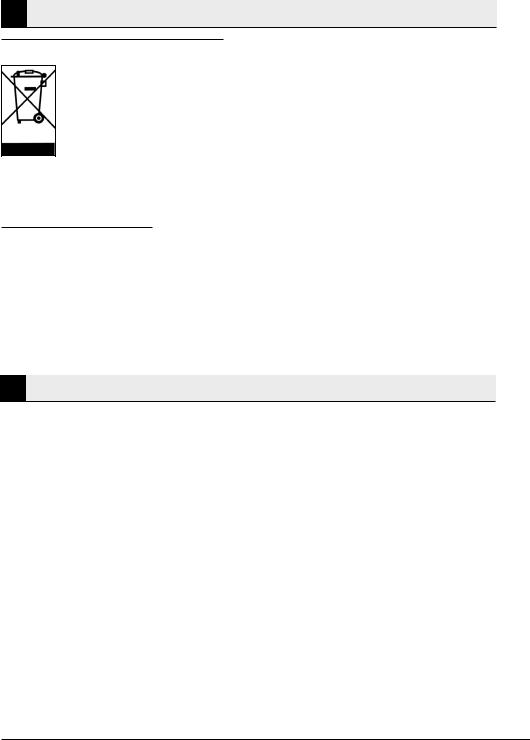
2 Important instructions for environment
2.1 Compliance with WEEE Directive
This product complies with EU WEEE Directive (2012/19/EU). This product bears a classification symbol for waste electrical and electronic equipment (WEEE).
This product has been manufactured with high quality parts and materials which can be reused and are suitable for recycling. Do not dispose of the waste product with normal domestic and other wastes at the end of its service life. Take it to the collection center for the recycling of electrical and electronic equipment. Please consult your local authorities to learn about these collection centers.
Compliance with RoHS Directive:
The product you have purchased complies with EU RoHS Directive (2011/65/EU). It does not contain harmful and prohibited materials specified in the Directive.
2.2 Package information
Packaging materials of the product are manufactured from recyclable materials in accordance with our National Environment Regulations. Do not dispose of the packaging materials together with the domestic or other wastes. Take them to the packaging material collection points designated by the local authorities.
3Intended use
•This product has been designed for domestic use. It is not for commercial purposes or it should not be used out of its intended use.
•The product must only be used for washing and rinsing of laundry that are marked accordingly.
•The manufacturer waives any responsibility arisen from incorrect usage or transportation.
•The service life of your product is 10 years. During this period, original spare parts will be available to operate the appliance properly.
Washing Machine / User’s Manual |
5 / EN |

4 |
|
Technical specifications |
|
|
Complying Commission Delegated Regulation (EU) No 1061/2010 |
|
|||
Supplier name or trademark |
|
Beko |
||
Model name |
|
WTE 5411 B0 |
||
Rated capacity (kg) |
|
5 |
||
Energy efficiency class / Scale from A+++ (Highest Efficiency) to D (Lowest Efficiency) |
A++ |
|||
Annual Energy Consumption (kWh) (1) |
|
148 |
||
Energy consumption of the standard 60°C cotton programme at full load (kWh) |
0,700 |
|||
Energy consumption of the standard 60°C cotton programme at partial load |
(kWh) |
0,630 |
||
Energy consumption of the standard 40°C cotton programme at partial load |
(kWh) |
0,605 |
||
Power consumption in ‘off-mode’ (W) |
|
0,250 |
||
Power consumption in ‘left-on mode’ (W) |
|
0,750 |
||
Annual Water Consumption (l) (2) |
|
9899 |
||
Spin-drying efficiency class / Scale from A (Highest Efficiency) to G (Lowest Efficiency) |
D |
|||
Maximum spin speed (rpm) |
|
800 |
||
Remaining moisture Content (%) |
|
71 |
||
Standard cotton programme (3) |
|
Cotton Eco 60°C and 40°C |
||
Programme time of the standard 60°C cotton programme at full load (min) |
|
214 |
||
Programme time of the standard 60°C cotton programme at partial load (min) |
172 |
|||
Programme time of the standard 40°C cotton programme at partial load (min) |
163 |
|||
Duration of the left-on mode (min) |
|
N/A |
||
Airborne acoustical noise emissions washing/spinning (dB) |
|
60/76 |
||
Built-in |
|
|
No |
|
Height (cm) |
|
84 |
||
Width (cm) |
|
60 |
||
Depth (cm) |
|
44 |
||
Net weight (±4 kg.) |
|
55 |
||
Single Water inlet / Double Water inlet |
|
• / - |
||
• Available |
|
|||
|
|
|||
Electrical input (V/Hz) |
|
230 V / 50Hz |
||
Total current (A) |
|
10 |
||
Total power (W) |
|
1550 |
||
Main model code |
|
9213 |
||
(1)Energy Consumption based on 220 standard washing cycles for cotton programmes at 60°C and 40°C at full and partial load, and the consumption of the low-power modes. Actual energy consumption will depend on how the appliance is used.
(2)Water consumption based on 220 standard washing cycles for cotton programmes at 60°C and 40°C at full and partial load. Actual water consumption will depend on how the appliance is used.
(3)“Standard 60°C cotton programme” and the “standard 40°C cotton programme” are the standard washing programmes to which the information in the label and the fiche relates and these programmes are suitable to clean normally soiled cotton laundry and that they are the most efficient programmes in terms of combined energy and water consumption.
Technical specifications may be changed without prior notice to improve the quality of the product.
6 / EN |
Washing Machine / User’s Manual |
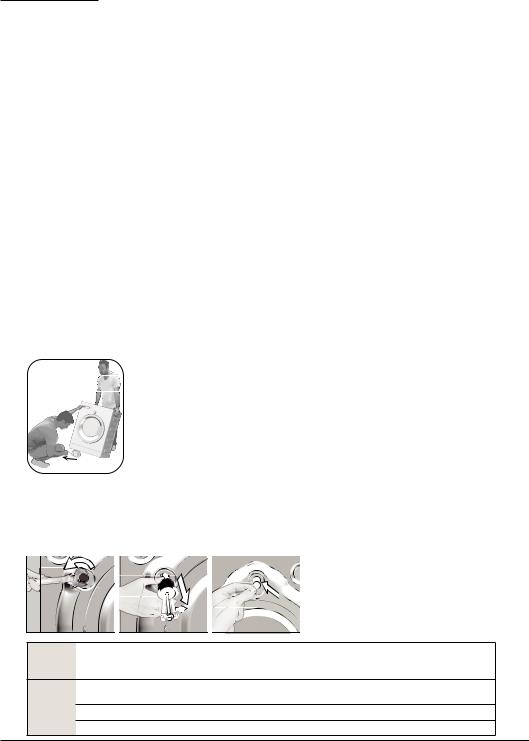
4.1 Installation
•Apply to the nearest authorised service agent for the installation of your product.
•Preparation of the location and electrical, tap water and waste water installations at the place of installation is under customer's responsibility.
•Make sure that the water inlet and discharge hoses as well as the power cable are not folded, pinched or crushed while pushing the product into its place after installation or cleaning procedures.
•Make sure that the installation and electrical connections of the product are performed by authorised service. Manufacturer shall not be held liable for damages that may arise from procedures carried out by unauthorised persons.
•Prior to installation, visually check if the product has any defects on it. If so, do not have it installed. Damaged products cause risks for your safety.
4.1.1Appropriate installation location
•Place the product on a hard and level floor. Do not put it onto a carpet with high pile or other similar surfaces.
•When the washing machine and dryer are placed on top of each other, their total weight –when loaded– amounts to 180 kilograms. Place the product on a solid and flat floor that has sufficient load carrying capacity!
•Do not place the product on the power cable.
•Do not install the product in the environments where the temperature falls below 0 ºC.
•Leaving a gap at the sides of the machine is suggested to reduce vibration and noise
•On a graduated floor, do not place the product next to the edge or on a platform.
•Do not place heat sources such as Hobs, Irons, Ovens, etc. on the washing machine and do not use them on the product.
4.1.2Removing packaging reinforcement
Tilt the machine backwards to remove the packaging reinforcement. Remove the packaging reinforcement by pulling the ribbon. Do not make this operation alone by yourself.
4.1.3 Removing the transportation locks
1Loosen all bolts with an appropriate wrench until they turn freely.
2Remove the transport safety bolts by turning them slightly.
3Insert the plastic covers in the bag containing the user manual to the openings on the rear panel.
A CAUTION: Remove the transportation safety bolts before operating the washing machine! Otherwise, the product will be damaged.
C Keep the transportation safety bolts in a safe place to reuse when the washing machine needs to be moved again in the future.
Install the transport safety bolts in reverse order of the disassembly procedure.
Never move the product without the transportation safety bolts properly fixed in place!
Washing Machine / User’s Manual |
7 / EN |

4.1.4 Connecting water supply
C The water supply pressure required to run the product is between 1 to 10 bars (0.1 – 1 MPa). It is necessary to have 10 – 80 liters of water flowing from the fully open tap in one minute to have your machine run smoothly. Attach a pressure reducing valve if water pressure is higher.
A CAUTION: Models with a single water inlet should not be connected to the hot water tap. In such a case the laundry will get damaged or the product will switch to protection mode and will not operate.
CAUTION: Do not use old or used water inlet hoses on the new product. It may cause stains on your laundry.
1Tighten the nuts of the hose by hand. Never use a tool when tightening the nuts.
2When hose connection is completed, check whether there is leak problems at the connection points by opening the taps fully. If any leaks occur, turn off the tap and remove the nut.
Retighten the nut carefully after checking the seal. In order to prevent the water leaks and resultant damages, keep the taps closed when you do not use the product.
4.1.5Connecting the drain hose to the drain
•Attach the end of the drain hose directly to waste water drain, lavatory or bathtub.
A CAUTION: Your drain house will be flooded if the hose comes out of its housing during water discharge. Moreover, there is risk of scalding due to high washing temperatures! In order to prevent such situations and make sure that the machine performs water intake and discharge processes without any problem, fix the drain hose securely.
<![endif]>100 cm 40 cm
•Connect the drain hose to a minimum height of 40 cm and a maximum height of 100 cm.
•In case the drain hose is elevated after laying it on the floor level or close to the ground (less than 40 cm above the ground), water discharge becomes more difficult and the laundry may come out excessively wet. Therefore, follow the heights described in the figure.
•To prevent the waste water to go back into the machine again and to ensure easy drainage, do not immerse the end of the hose into the waste water or do not insert it into the drain for more than 15 cm. If it is too long, cut it short.
•The end of the hose should not be bent, it should not be stepped on and the hose must not be pinched between the drain and the machine.
•If the length of the hose is too short, use it by adding an original extension hose. Length of the hose may not be longer than 3.2 m. To avoid water leak failures, the connection between the extension hose and the drain hose of the product must be fitted well with an appropriate clamp as not to come off and leak.
8 / EN |
Washing Machine / User’s Manual |
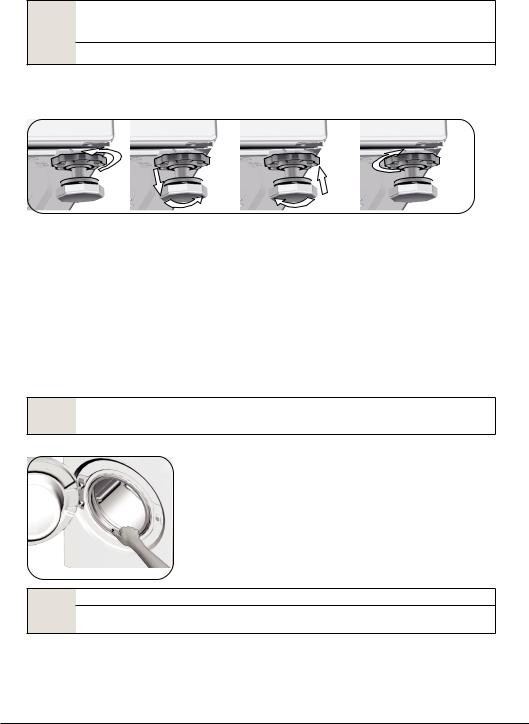
4.1.6 Adjusting the feet
A CAUTION: In order to ensure that the product operates more silently and vibration-free, it must stand level and balanced on its feet. Balance the machine by adjusting the feet. Otherwise, the product may move from its place and cause crushing and vibration problems.
CAUTION: Do not use any tools to loosen the lock nuts. Otherwise, they will get damaged.
1 Loosen the lock nuts on the feet by hand.
2 Adjust the feet until the product stands in a stable and balanced way. 3. Tighten all lock nuts by hand again.
4.1.7 Electrical connection
Connect the product to a grounded outlet protected by a 16 A fuse. Our company shall not be liable for any damages that will arise when the product is used without grounding in accordance with the local regulations.
• Connection must comply with national regulations.
• The wiring for the electrical outlet circuit must be sufficient to meet the appliance requirements. Use of a Groud Fault Circuit Interrupter (GFCI) is recommended.
• Power cable plug must be within easy reach after installation.
• If the current value of the fuse or breaker in the house is less than 16 Amps, have a qualified electrician install a 16 Amp fuse.
• The voltage specified in the "Technical specifications" section must be equal to your mains voltage.
• Do not make connections via extension cables or multi-plugs.
B CAUTION: Damaged power cables must be replaced by the Authorised Service Agents.
4.1.8 Initial use
Before starting to use the product make sure that the preparations are made which are in line with the “Important Safety and Environment Instructions” and the instructions in the “Installation” section.
To prepare the product for washing laundry, perform first operation in Drum Cleaning programme. If this program is not available in your machine, apply the method which is described in the section 4.4.2.
C Use an anti-limescale suitable for the washing machines.
Some water might have remained in the product due to the quality control processes in the production. It is not harmful for the product.
Washing Machine / User’s Manual |
9 / EN |

4.2 Preparation
4.2.1 Sorting the laundry
* Sort laundry according to type of fabric, color, and degree of soiling and allowable water temperature.
* Always obey the instructions given on the garment tags.
4.2.2 Preparing laundry for washing
• Laundry items with metal attachments such as, underwired bras, belt buckles or metal buttons will damage the machine. Remove the metal pieces or wash the clothes by putting them in a laundry bag or pillow case.
• Take out all substances in the pockets such as coins, pens and paper clips, and turn pockets inside out and brush. Such objects may damage the product or cause noise problem.
• Put small size clothes such as infant's socks and nylon stockings in a laundry bag or pillow case.
• Place curtains in without compressing them. Remove curtain attachment items.
• Fasten zippers, sew loose buttons and mend rips and tears.
• Wash “machine washable” or “hand washable” labeled products only with an appropriate programme.
• Do not wash colours and whites together. New, dark coloured cottons release a lot of dye. Wash them separately.
• Tough stains must be treated properly before washing. If unsure, check with a dry cleaner.
• Only use the dyes / color changers and descaling agents which are appropriate to machine wash. Always follow the instructions on the package.
• Wash trousers and delicate laundry turned inside out.
• Keep laundry items made of Angora wool in the freezer for a few hours before washing. This will reduce pilling.
• Laundry that are subjected to materials such as flour, lime dust, milk powder, etc. intensely must be shaken off before placing into the machine. Such dusts and powders on the laundry may build up on the inner parts of the machine in time and can cause damage.
4.2.3 Things to be done for energy saving
Following information will help you use the product in an ecological and energy-efficient manner.
• Operate the product in the highest capacity allowed by the programme you have selected, but do not overload; see, "Programme and consumption table". See, “Programme and consumption table"
• Always follow the instructions on the detergent packaging.
• Wash slightly soiled laundry at low temperatures.
• Use faster programmes for small quantities of lightly soiled laundry.
• Do not use prewash and high temperatures for laundry that is not heavily soiled or stained.
• If you plan to dry your laundry in a dryer, select the highest spin speed recommended during washing process.
• Do not use more detergent than the recommended amount specified on its package.
4.2.4Loading the laundry
1.Open the laundry cover.
2.Put the laundry items into the machine in a loose manner.
3.Push and close the loading cover until you hear the locking sound. Ensure that no items are caught in the door. The loading door is locked while a programme is running. The door can only be opened a while after the programme comes to an end.
4.2.5 Correct load capacity
The maximum load capacity depends on the type of laundry, the degree of soiling and the washing programme desired.
Machine automatically adjusts the water amount according to the weight of the laundry put inside it.
A WARNING: Follow the information in the “Programme and consumption table”. When overloaded, machine's washing performance will drop. Moreover, noise and vibration problems may occur.
10 / EN |
Washing Machine / User’s Manual |

4.2.6 Using detergent and softener
C When using detergent, softener, starch, fabric dye, bleacher and decolorant, descaling agents; read the manufacturer's instructions written on the package and follow the dosages specified. Use measuring cup if available.
2  3 1
3 1
 The detergent drawer is composed of three compartments:
The detergent drawer is composed of three compartments:
–(1) for prewash
–(2) for main wash
–(3) for softener
–( ) in addition, there is a siphon piece in the softener compartment.
) in addition, there is a siphon piece in the softener compartment.
Detergent, softener and other cleaning agents |
|||
• Add detergent and softener before starting the washing programme. |
|||
• |
While the washing cycle is in progress, do not leave the detergent dispenser open! |
||
• When using a programme without prewash, do not put any detergent into the prewash |
|||
|
compartment (compartment nr. "1"). |
||
• In a programme with prewash, do not put liquid detergent into the prewash compartment |
|||
|
(compartment nr. "1"). |
||
• Do not select a programme with prewash if you are using a detergent bag or dispensing ball. Place |
|||
|
the detergent bag or the dispensing ball directly among the laundry in the machine. |
||
If you are using liquid detergent, do not forget to place the liquid detergent container into the main |
|||
|
wash compartment (compartment number “2”). |
||
Choosing the detergent type |
|||
Detergent type to be used depends on the fabric type and color. |
|||
• Use different detergents for coloured and white laundry. |
|||
• Wash your delicate clothes only with special detergents (liquid detergent, wool shampoo, etc.) |
|||
• |
used solely for delicate clothes. |
||
When washing dark coloured clothes and quilts, it is recommended to use liquid detergent. |
|||
• |
Wash woolens with special detergent made specifically for woolens. |
||
A |
CAUTION: Use only detergents manufactured specifically for washing machines. |
||
CAUTION: Do not use soap powder. |
|||
|
|
||
Adjusting detergent amount
The amount of washing detergent to be used depends on the amount of laundry, the degree of soiling and water hardness.
• Do not use amounts exceeding the dosage quantities recommended on the detergent package to avoid problems of excessive foam, poor rinsing, financial savings and finally, environmental protection.
• Use lesser detergent for small amounts or lightly soiled clothes.
Using softeners
Pour the softener into the softener compartment of the detergent drawer.
• Do not exceed the (>max<) level sign on the softener compartment.
• If the softener has lost its fluidity, dilute it with water before putting it in the detergent drawer.
Using liquid detergents
Washing Machine / User’s Manual |
11 / EN |

If the product contains a liquid detergent cup:
2
•Put the liquid detergent container into the compartment no “2”.
•If the liquid detergent lost its fluidity, dilute it with water before putting it into the detergent container.
If the product is equipped with a liquid detergent part:
• When you want to use liquid detergent, pull the apparatus towards yourself. The part that falls down will serve as a barrier for the liquid detergent.
• If required, clean the apparatus with water when it is in place or by removing it.
• If you will use powder detergent, the apparatus must be secured at top position.
If the product does not contain a liquid detergent cup:
• Do not use liquid detergent for the prewash in a programme with prewash.
• Liquid detergent stains your clothes when used with Delayed Start function. If you are going to use the Delayed Start function, do not use liquid detergent.
Using gel and tablet detergent
• If the gel detergent thickness is fluidal and your machine does not contain a special liquid detergent cup, put the gel detergent into the main wash detergent compartment during first water intake. If your machine contains a liquid detergent cup, fill the detergent into this cup before starting the programme.
• If the gel detergent thickness is not fluidal or in the shape of capsule liquid tablet, put it directly into the drum before washing.
• Put tablet detergents into the main wash compartment (compartment nr. "2") or directly into the drum before washing.
Using starch
• Put the liquid soda, powder soda or the fabric dye into the softener compartment. Do not use softener and starch together in a washing cycle.
Wipe the inside of the machine with a damp and clean cloth after using starch.
Using limescale remover
• When required, use limescale removers manufactured specifically for washing machines only.
Using bleaches
• Add the bleach at the beginning of the washing cycle by selecting a prewash program. Do not put detergent in the prewash compartment. As an alternative application, select a programme with extra rinse and add the bleaching agent while the machine is taking water from the detergent compartment during first rinsing step.
• Do not use bleaching agent and detergent by mixing them.
• Use just a little amount (approx. 50 ml) of bleaching agent and rinse the clothes very well as it causes skin irritation. Do not pour the bleach onto the laundry and do not use it with the colored items.
• When using oxygen-based decolorant, select a program which washes the laundry at a low temperature.
• Oxygen-based decolorant can be used with the detergent; however, if it is not at the same consistence, first put detergent in the compartment number “2” in the detergent dispenser and wait for the machine to flush the detergent when taking in water. While the machine continues taking in water, add decolorant in the same compartment.
12 / EN |
Washing Machine / User’s Manual |

4.2.7 Tips for efficient washing
<![endif]>Soiling Level
|
|
|
|
Clothes |
|
||
|
Light Colours and |
|
Colours |
Black/Dark |
Delicates/ |
||
|
Whites |
|
|
Colours |
Woolens/Silks |
||
|
|
|
|
||||
|
(Recommended |
|
|
(Recommended |
(Recommended |
(Recommended |
|
|
|
|
temperature range based |
temperature range |
temperature range |
||
|
temperature range based |
||||||
|
on soiling level: 40-90 |
o |
C) |
on soiling level: cold -40 |
based on soiling |
based on soiling |
|
|
|
oC) |
level: cold -40 oC) |
level: cold -30 oC) |
|||
|
It may be necessary to pre- |
Powder and liquid |
|
|
|||
|
treat the stains or perform |
detergents recommended |
|
Prefer liquid |
|||
Heavily |
prewash. Powder and liquid |
for colors can be used at |
Liquid detergents |
||||
detergents |
|||||||
Soiled |
detergents recommended |
dosages recommended |
suitable for |
produced for |
|||
for whites can be used at |
|
for heavily soiled clothes. |
colors and dark |
||||
|
dosages recommended |
|
|
It is recommended to use |
colors can be |
delicate clothes. |
|
(difficult stains |
|
|
Woolen and silk |
||||
for heavily soiled clothes. |
powder detergents to |
used at dosages |
|||||
such as grass, |
It is recommended to use |
|
clean clay and soil stains |
recommended |
clothes must |
||
coffee, fruits |
powder detergents to |
|
|
and the stains that are |
for heavily soiled |
be washed with |
|
and blood.) |
clean clay and soil stains |
|
sensitive to bleaches. |
clothes. |
special woolen |
||
|
and the stains that are |
|
|
Use detergents without |
|
detergents. |
|
|
sensitive to bleaches. |
|
|
bleach. |
|
|
|
|
|
|
|
|
|
|
|
Normally |
Powder and liquid |
|
|
Powder and liquid |
Liquid detergents |
Prefer liquid |
|
Soiled |
|
|
detergents recommended |
suitable for |
detergents |
||
detergents recommended |
for colors can be used at |
colors and dark |
produced for |
||||
(For example, |
for whites can be used at |
dosages recommended |
colors can be |
delicate clothes. |
|||
stains caused |
dosages recommended |
|
for normally soiled |
used at dosages |
Woolen and silk |
||
by body on |
for normally soiled |
|
|
clothes. Detergents which |
recommended for |
clothes must be |
|
collars and |
clothes. |
|
|
do not contain bleach |
normally soiled |
washed with special |
|
cuffs) |
|
|
|
should be used. |
clothes. |
woolen detergents. |
|
|
|
|
|
Powder and liquid |
Liquid detergents |
Prefer liquid |
|
Lightly |
Powder and liquid |
|
|
detergents recommended |
suitable for |
detergents |
|
Soiled |
detergents recommended |
for colors can be used at |
colors and dark |
produced for |
|||
dosages recommended |
colors can be |
delicate clothes. |
|||||
|
for whites can be used at |
for lightly soiled clothes. |
used at dosages |
Woolen and silk |
|||
(No visible |
dosages recommended |
|
|||||
|
Detergents which do not |
recommended |
clothes must be |
||||
stains exist.) |
for lightly soiled clothes. |
contain bleach should |
for lightly soiled |
washed with special |
|||
|
|
|
|
be used. |
clothes. |
woolen detergents. |
|
|
|
|
|
|
|
|
|
Washing Machine / User’s Manual |
13 / EN |
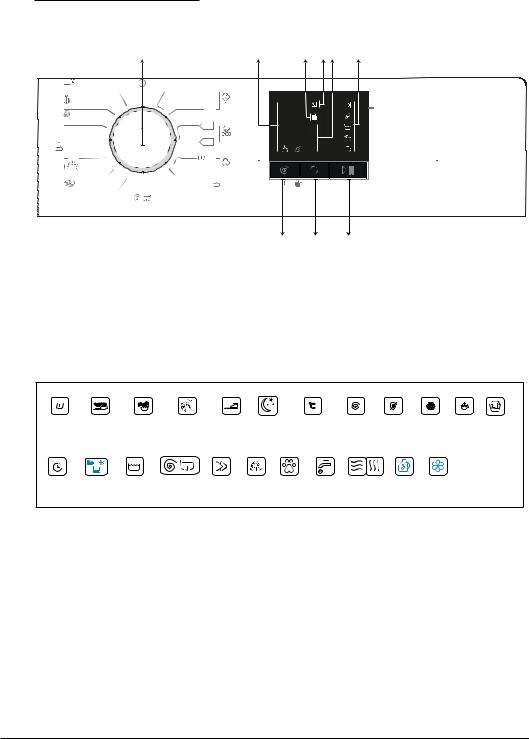
4.3 Operating the product
4.3.1 Control panel
|
|
1 |
|
Daily Xpress |
On / O |
|
Shirts 40° |
|
|
Woollens 40° |
|
|
Hand Wash 40° |
|
|
40º |
|
Synthetics |
20º |
|
|
Down Wear 40º |
|
|
Drum Clean |
|
|
|
Spin+Drain |
|
2 |
3 |
4 |
5 |
6 |
20º |
|
|
|
|
WTE 5411 B0 |
|
|
|
|
|
|
|
Cottons |
800 |
|
|
End |
40º |
|
|
Cancel |
||
|
|
700 |
|
|
Spin |
40º |
|
600 |
9 |
|
Rinse |
60º |
Cottons Eco |
400 |
6 |
|
Wash |
|
|
3 |
|
Time Delay |
|
|
|
|
|
||
60° |
|
|
|
|
|
90º |
Cottons |
|
|
|
|
Rinse |
|
|
|
|
|
|
9 |
8 |
7 |
1 - Programme Selection knob (Uppermost |
5 - Delayed Start Indicator LEDs |
||
position On / Off) |
6 |
- Programme Follow-up LEDs |
|
2 |
- Spin Speed Indicator LEDs |
7 - Start / Pause Button |
|
3 |
- Child Lock Enabled LED |
8 - Delayed Start Setting Button |
|
4 - Door Lock Enabled LED |
9 |
- Spin Speed Adjustment button |
|
|
|
|
|
Pre-wash |
Fast+ |
Rinse |
Pet hair |
Anti |
Night |
Temperature |
Spin |
No |
Cold |
Rinse |
Rinse |
|
|
|
Plus |
removal |
creasing |
mode |
|
|
|
spin |
|
hold |
hold |
Time |
Auto |
Rinse |
Spin+Pump |
Fast+ |
Steam Pet hair |
Cold |
Drying |
Auto |
Softener |
|
|
|
delay |
Dosing |
|
|
|
removal |
|
|
Dosing |
Selection |
|
||
4.3.2 Preparing the machine
1.Make sure that the hoses are connected tightly. 2.Plug in your machine.
3.Turn the tap on completely. 4.Place the laundry in the machine. 5.Add detergent and fabric softener.
4.3.3 Programme selection and tips for efficient washing
1.Select the programme suitable for the type, quantity and soiling degree of the laundry in accordance with the "Programme and consumption table" and the temperature table below.
2.Select the desired programme with the Programme Selection knob.
14 / EN |
Washing Machine / User’s Manual |

4.3.4 Programme and consumption table
EN |
|
2 |
|
|
|
|
|
|
|
|
|
|
|
|
|
Programme |
|
|
<![if ! IE]> <![endif]>(kg)LoadMax. |
<![if ! IE]> <![endif]>DurationProgramme(~min) |
<![if ! IE]> <![endif]>ConsumptionWater(l) |
<![if ! IE]> <![endif]>ConsumptionEnergy(kWh) |
<![if ! IE]> <![endif]>Speed***Max. |
|
|
|
|
|
|
|
|
|
|
|
|
|
|
|
|
|
90 |
|
5 |
180 |
82 |
1,75 |
800 |
|
|
|
|
|
|
|
|
Cottons |
40 |
|
5 |
180 |
80 |
0,90 |
800 |
|
|
|
|
|
|
|
|
|
20 |
|
5 |
180 |
80 |
0,50 |
800 |
|
|
|
|
|
|
|
|
Prewash-Cottons |
60 |
|
5 |
200 |
90 |
1,60 |
800 |
|
|
|
|
|
|
|
|
|
60** |
|
5 |
214 |
47,4 |
0,700 |
800 |
|
|
|
|
|
|
|
|
Cottons Eco |
60** |
|
2,5 |
172 |
45 |
0,630 |
800 |
|
|
|
|
|
|
|
|
|
40** |
|
2,5 |
163 |
41,4 |
0,605 |
800 |
|
|
|
|
|
|
|
|
Synthetics |
40 |
|
2,5 |
120 |
66 |
0,75 |
800 |
|
|
|
|
|
|
|
|
20 |
|
2,5 |
120 |
66 |
0,25 |
800 |
|
|
|
||||||
|
|
|
|
|
|
|
|
Daily Xpress |
30 |
|
5 |
28 |
59 |
0,15 |
800 |
|
|
|
|
|
|
|
|
Woollens / Hand Wash |
40 |
|
1,5 |
65 |
45 |
0,45 |
800 |
|
|
|
|
|
|
|
|
Down Wear |
40 |
|
1,5 |
105 |
85 |
0,80 |
800 |
|
|
|
|
|
|
|
|
Shirts |
40 |
|
2,5 |
80 |
42 |
0,60 |
800 |
|
|
|
|
|
|
|
|
Drum Clean |
90 |
|
- |
160 |
67 |
2,10 |
600 |
|
|
|
|
|
|
|
|
** : Energy Label programme (EN 60456 Ed.3)
***: If maximum spin speed of the machine is lower then this value, you can only select up to the maximum spin speed. - : See the programme description for maximum load.
|
** "Cotton Economic 40°C and Cotton Economic 60°C are standard programmes." These programmes are known as '40°C |
||
|
cotton standard programme' and '60°C cotton standard programme' and indicated with the |
symbols on the |
|
|
panel. |
|
|
C |
Water and power consumption may vary subject to the changes in water pressure, water hardness and temperature, |
||
ambient temperature, type and amount of laundry, spin speed, and changes in electric voltage. |
|
||
Depending on the amount of laundry you have loaded into your machine, there may be a difference of 1-1.5 hours |
|||
|
|||
|
between the duration shown in the Programme and consumption table and the actual washing duration. Duration will |
||
|
be automatically updated soon after the washing starts. |
|
|
Washing Machine / User’s Manual |
15 / EN |

Indicative values for Synthetics programmes (EN)
|
<![if ! IE]> <![endif]>Load (kg) |
<![if ! IE]> <![endif]>Water Consumption (l) |
<![if ! IE]> <![endif]>Energy Consumption (kWh) |
<![if ! IE]> <![endif]>Programme Duration (min) * |
Synthetics 40 |
2,5 |
66 |
0,75 |
105/130 |
Synthetics 20 |
2,5 |
66 |
0.25 |
105/130 |
|
|
|
|
|
Remaining Moisture |
Remaining Moisture |
Content (%) ** |
Content (%) ** |
|
|
≤ 1000 rpm |
> 1000 rpm |
45 |
40 |
45 |
40 |
|
|
*You can see the washing time of the programme you have selected on the display of the machine. It is normal that small differences may occur between the time shown on the display and the real washing time.
**Remaining moisture content values may differ according to the selected spin speed.
4.3.5 Main programmes
Depending on the type of fabric, use the following main programmes.
• Cottons
Use this programme for your cotton laundry (sheets, bedlinen, towels, bathrobes, underwear etc.). Your laundry will be washed with vigorous washing action for a longer washing cycle.
• Synthetics
Use to wash your synthetic clothes (shirts, blouses, synthetic/cotton blends, etc.). Your laundry will be washed with a gentle action for a shorter washing cycle when compared to the Cottons programme. For curtains and tulle, it is recommended to use Synthetics 20˚C or 40˚C programme.
• Woollens / Hand Wash
Use to wash your woolen/delicate laundry. Your laundry will be washed with a very gentle washing action in order not to damage the clothes.
4.3.6 Additional programmes
For special cases, additional programmes are available in the machine.
C Additional programmes may differ according to the model of the machine.
• Cottons Eco
Use this programme to wash your laundry washable in cottons programme for a longer time, still with a very good performance for saving purposes.
C Cotton Eco programme consumes less energy compared to other cotton programmes.
• Prewash-Cottons
Use this programme only for heavily soiled cotton clothes. Add detergent into the prewash compartment.
• Daily Xpress
Use this programme to wash your lightly soiled cotton clothes in a short time.
16 / EN |
Washing Machine / User’s Manual |

• Shirts
This programme is used to wash the shirts made from cotton, synthetic and synthetic blended fabrics altogether. It reduces wrinkles. Pre-treatment algorithm is executed.
• Apply the pre-treatment chemical on your garments directly or add it together with detergent when the machine starts to take water from the main washing compartment. Thus the machine will wash them in a short period of time and expected lifespan of your shirts will extend.
• Down Wear
Use this programme to wash your coats, vest, jackets etc. containing feathers with a "machinewashable" label on them. Thanks to special spinning profiles, it is ensured that the water reaches the air gaps amongst the feathers.
• Drum Clean
Use regularly (once in every 1-2 months) to clean the drum and provide the required hygiene. Operate the programme while the machine is completely empty. To obtain better results, put powder lime-scale remover for washing machines into the detergent compartment no. “2”. When the programme is over, leave the loading door ajar so that the inside of the machine gets dry.
C This is not a washing programme. It is a maintenance programme.
Do not run the programme when there is something in the machine. If you try to do so, the machine detects that there is load inside and aborts the programme.
4.3.7 Special programmes
For specific applications, select any of the following programmes.
• Rinse
Use when you want to rinse or starch separately.
• Spin+Drain
You can use this function to remove the water on the garment of drain the water in the machine. Before selecting this programme, select the desired spin speed and press Start / Pause button. First, the machine will drain the water inside of it. Then, it will spin the laundry with the set spin speed and drain the water coming out of them.
If you wish to drain only the water without spinning your laundry, select the Pump+Spin programme and then select the No Spin function with the help of Spin Speed Adjustment button. Press Start / Pause button.
C Use a lower spin speed for delicate laundries.
4.3.8 Speed selection
Whenever a new programme is selected, the recommended spin speed of the selected programme is displayed on the spin speed indicator.
To decrease the spin speed, press the Spin Speed Adjustment button. Spin speed decreases gradually. Then, depending on the model of the product, "Rinse Hold" and "No Spin" options appear on the display. When "No Spin" is selected, the rinse level indicator lights will not turn on.
Rinse hold
If you are not going to unload your clothes immediately after the programme completes, you can use rinse hold function to keep your laundry in the final rinsing water in order to prevent them from getting wrinkled when there is no water in the machine. Press Start / Pause button after this process if you want to drain the water without spinning your laundry. Programme will resume and complete after draining the water.
If you want to spin the laundry held in water, adjust the Spin Speed and press Start / Pause button. The programme will resume. Water is drained, laundry is spun and the programme is completed.
C If the programme has not reached the spinning step, you can change the speed without switching the machine to Pause mode.
Washing Machine / User’s Manual |
17 / EN |

4.3.9 Delayed Start
With the Delayed Start function the startup of the programme may be delayed up to 3, 6 or 9 hours.
C Do not use liquid detergents when you set Delayed Start! There is the risk of staining of the clothes.
1.Open the loading door, place the laundry and put detergent, etc.
2.Select a washing programme and spin speed.
3.Set the desired time by pressing the Delayed Start button. When the button is pressed once, 3 hours delayed start is selected. When the same button is pressed again, 6 hours delay is selected, and when it is pressed for the third time, 9 hours delayed start is selected. If you press the Delayed Start button once again, Delayed Start function will be canceled.
4.Press Start / Pause button. Previous delayed start time light turns off and next delayed start time light turns on after every 3 hours.
5.At the end of the countdown, all delayed start lights will turn off and the selected programme will start.
C You can switch the machine to pause mode and add laundry during the delayed start period.
Changing the delayed start period
If you want to change the time during countdown, you will need to cancel the programme and set the delay time again.
Canceling the Delayed Start function
If you want to cancel the delayed start countdown and start the programme immediately:
1. Turn the Programme Selection knob to any programme. Thus, Delayed Start function will be canceled. The End/Cancel light flashes continuously.
2. Then, select the programme you want to run again. 3. Press Start / Pause button to start the programme.
4.3.10 Starting the programme
1. Press Start / Pause button to start the programme.
2. Programme follow-up light showing the startup of the programme will turn on.
4.3.11 Child Lock
Use Child Lock function to prevent children from tampering with the machine. Thus you can avoid any changes in a running programme.
C If the Programme Selection knob is rotated when the child lock is active, "Child Lock Enabled LED" will flash 3 times. The Child Lock does not allow any change in the programmes or the selected speed.
Even if another programme is selected with the Programme Selection knob while the Child Lock is active, previously selected programme will continue running.
When the Child Lock is active and the machine is running, you can switch the machine to Pause mode without deactivating the Child Lock by turning the Programme Selection knob to On / Off position. When you turn the Programme Selection knob afterwards, the programme will resume.
To activate the Child Lock:
Press and hold Speed and Delayed Start buttons for 3 seconds. While you are holding for 3 seconds, the "Child Lock Enabled LED" will flash. You can release the buttons when the LEDs become permanently on.
18 / EN |
Washing Machine / User’s Manual |

To deactivate the Child Lock:
Press and hold Speed and Delayed Start buttons for 3 seconds while any programme is running. While you are holding for 3 seconds, the "Child Lock Enabled LED" will flash. You can release the buttons when the LED turns off completely.
C In addition to the method above, to deactivate the Child Lock, switch the Programme Selection knob to On / Off position when no programme is running, and select another programme.
Child Lock is not deactivated after power failures or when the machine is unplugged.
4.3.12 Progress of programme
Progress of a running programme can be followed from the Programme Follow-up indicator. At the beginning of every programme step, the relevant indicator light will turn on and light of the completed step will turn off.
You can change the speed settings without stopping the programme flow while the programme is running. To do this, the change you are going to make must be in a step after the running programme step. If the change is not compatible, relevant lights will flash for 3 times.
C If the machine does not proceed to the spinning step, the Rinse Hold function might be active or the automatic unbalanced load detection system might be activated due to the unbalanced distribution of the laundry in the machine.
4.3.13 Loading door lock
There is a locking system on the loading door of the machine that prevents opening of the loading door in cases when the water level is unsuitable.
Loading door light will start flashing when the machine is switched to Pause mode. The machine checks the level of the water inside. If the level is suitable, the Loading Door light turns off and the loading door can be opened within 1-2 minutes.
If the level is unsuitable, the Loading Door light remains on and the loading door cannot be opened. If you are obliged to open the Loading Door while the Loading Door light is on, you must cancel the current programme. See. "Cancelling the programme"
4.3.14 Changing the selections after programme has started
Switching the machine to pause mode
Press the Start / Pause button to switch the machine to pause mode while a programme is running. The light of the step which the machine is in starts flashing in the Programme Follow-up indicator to show that the machine has been switched to the pause mode.
Additionally, when the loading door is openable, the Loading Door light turns off completely.
Changing the speed settings
You can change the speed settings of the programme that is currently running. See "Speed selection".
C If no change is allowed, the relevant light will flash 3 times.
Washing Machine / User’s Manual |
19 / EN |

Adding or taking out laundry
You can load/unload laundry when a programme is running if the water level is appropriate to open the door. To do this:
1. Press Start / Pause button to switch the machine to pause mode. The programme follow-up light of the relevant step during which the machine was switched into the pause mode will flash.
2. Wait until the Loading Door can be opened.
3. Open the Loading Door and add or take out the laundry. 4. Close the Loading Door.
5. Make changes in speed settings, if necessary. 6. Press Start / Pause button to start the machine.
4.3.15 Cancelling the programme
To cancel the programme, turn the Programme Selection knob to select another programme. Previous programme will be cancelled. End / Cancel light will flash continuously to notify that the programme has been canceled.
Your machine will end the programme when you turn the Programme Selection knob; however, it does not drain the water inside. When you select and start a new programme, the newly selected programme will start depending on the step the previous programme was canceled in. For example, it may take in additional water or continue to wash with the water inside.
C Some programmes may start by discharging the water inside the machine. Depending on the step where the programme was canceled in, you may have to put detergent and softener again for the programme you have selected anew.
4.3.16 End of programme
When the programme ends, "End" LED becomes on at the Programme Follow-up indicator. 1. Wait until the "Door Lock Enabled LED" goes off completely.
2. To switch off the machine, turn the Programme Selection Knob to On/Off position.
3. Take out your laundry and close the loading door. Your machine is ready for the next washing cycle.
4.3.17 Your machine features "Pause Mode".
After you switch on your machine with the programme selection button (by switching the button to a different position than the On/Off position), if no programme is started or no other procedure is performed in the selection step or no action is taken within approx. 2 minutes after the selected programme ends, your machine will switch to energy saving mode automatically. The brightness of the indicator lights will decrease. Also, if your product has a display that shows programme time, this display will be completely turned off. If you turn the Programme Selection knob or touch any button,
lights and display will switch back to previous condition. The selections which you make when exiting from the energy efficiency may change. Please check the correctness of your selections before starting the programme. If necessary, please make your settings again. This is not an error.
20 / EN |
Washing Machine / User’s Manual |
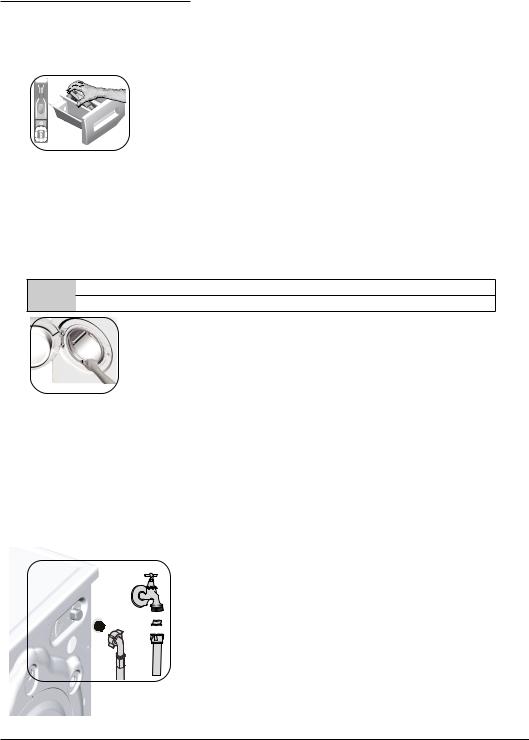
4.4 Maintenance and cleaning
Service life of product extends and frequently experienced problems will be reduced if it is cleaned at regular intervals.
4.4.1 Cleaning the detergent drawer
Clean the detergent drawer at regular intervals (every 4-5 washing cycles)
as shown below in order to prevent accumulation of powder detergent in
time.
Lift the rear part of the siphon to remove it as illustrated.
If more than normal amount of water and softener mixture starts to gather in the softener compartment, the siphon must be cleaned.
1 Press the dotted point on the siphon in the softener compartment and pull towards you until the compartment is removed from the machine.
2. Wash the detergent drawer and the siphon with plenty of lukewarm water in a washbasin. In order to prevent the residues to contact your skin, clean it with an appropriate brush by wearing a pair of gloves.
3 Insert the drawer back into its place after cleaning and make sure that it is seated well.
4.4.2 Cleaning the loading door and the drum
For products with drum cleaning programme, please see Operating the product - Programmes.
C
After every washing make sure that no foreign substance is left in the drum. If the holes on the bellow shown in the figure is blocked, open the holes using a toothpick.
Foreign metal substances will cause rust stains in the drum. Clean the stains on the drum surface by using cleaning agents for stainless steel.
Never use steel wool or wire wool. These will damage the painted, chromated and plastic surfaces.
4.4.3 Cleaning the body and control panel
Wipe the body of the machine with soapy water or non-corrosive mild gel detergents as necessary, and dry with a soft cloth.
Use only a soft and damp cloth to clean the control panel.
4.4.4 Cleaning the water intake filters
There is a filter at the end of each water intake valve at the rear of the machine and also at the end of each water intake hose where they are connected to the tap. These filters prevent foreign
substances and dirt in the water to enter the washing machine. Filters should be cleaned as they do get dirty.
1. |
Close the taps. |
|
2. |
Remove the nuts of the water intake hoses to access |
|
|
the filters on the water intake valves. Clean them |
|
|
with an appropriate brush. If the filters |
are too dirty, |
|
remove them from their places with a pliers and clean |
|
3. |
in this way. |
|
Take out the filters on the flat ends of the water |
||
|
intake hoses together with the gaskets |
and clean |
4. |
thoroughly under running water. |
|
Replace the seals and filters carefully and tighten |
||
|
their nuts by hand. |
|
Washing Machine / User’s Manual |
21 / EN |
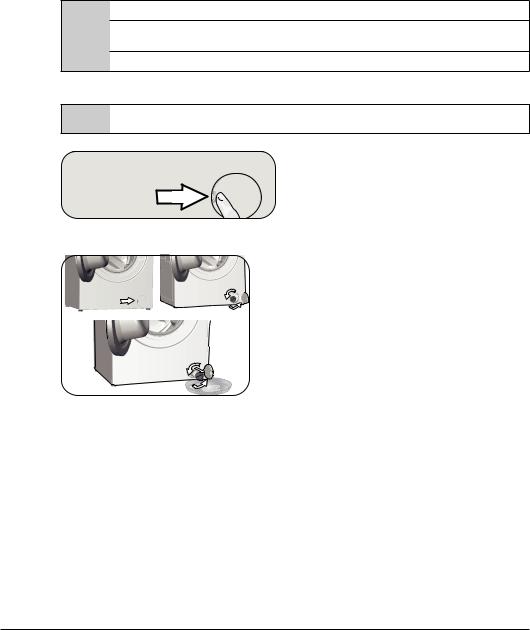
4.4.5 Draining remaining water and cleaning the pump filter
The filter system in your machine prevents solid items such as buttons, coins and fabric fibers clogging the pump impeller during discharge of washing water. Thus, the water will be discharged without any problem and the service life of the pump will extend.
If the machine fails to drain water, the pump filter is clogged. Filter must be cleaned whenever it is clogged or in every 3 months. Water must be drained off first to clean the pump filter.
In addition, prior to transporting the machine (e.g., when moving to another house) and in case of freezing of the water, water may have to be drained completely.
A CAUTION: Foreign substances left in the pump filter may damage your machine or may cause noise problem.
CAUTION: If the product is not being used, shut the tap shut, remove mains pipe and drain the water inside the machine against any likely freezing.
CAUTION: After each use, turn off the water tap to which the mains hose is connected.
In order to clean the dirty filter and discharge the water:
1 Unplug the machine to cut off the supply power.
A CAUTION: Temperature of the water inside the machine may rise up to 90 ºC. To avoid the burning risk, clean the filter after the water inside the machine is cooled down.
2. Open the filter cover.
3 Follow the below procedures in order to drain water.
The product does not have an emergency water drain hose, in order to drain the water:
a. In order to collect the water to flow out of the filter, place a large vessel in front of the filter.
b. Turn and loosen the pump filter until water starts to flow (counterclockwise). Fill the flowing water into the container you have placed in front of the filter. Always keep a piece of cloth handy to absorb any spilled water.
c When the water inside the machine is finished, take out the filter completely by turning it.
4.Clean any residues inside the filter as well as fibers, if any, around the pump impeller region.
5.Replace the filter.
6.If the filter cap is composed of two pieces, close the filter cap by pressing on the tab. If it is one piece, seat the tabs in the lower part into their places first, and then press the upper part to close
22 / EN |
Washing Machine / User’s Manual |

5 |
Troubleshooting |
|
|
|
|
|
|
|
|
|
Problem |
Reason |
Solution |
|
Program does not start after |
Start / Pause / Cancel button was not pressed. |
• *Press the Start / Pause / Cancel button. |
|
|
closing the door. |
|
|
|
|
It may be difficult to close the loading door in case |
• Reduce the amount of laundry and make sure |
|
||
|
|
of excessive loading. |
that the loading door is closed properly. |
|
Programme cannot be started or |
Washing machine has switched to self protection |
• To cancel the programme, turn the |
|
|
selected. |
mode due to a supply problem (line voltage, water |
Programme Selection knob to select another |
|
|
|
|
pressure, etc.). |
programme. Previous programme will be |
|
|
|
|
canceled. (see. “Cancellation of program”) |
|
Water in the machine. |
Some water might have remained in the product |
• This is not a failure; water is not harmful to |
|
|
|
|
due to the quality control processes in the |
the machine. |
|
|
|
production. |
|
|
The machine enters standby |
Tap is turned off. |
• Turn on the taps. |
|
|
mode after the programme |
Water inlet hose is bent. |
• Flatten the hose. |
|
|
starts or it does not take in |
|
|
|
|
Water inlet filter is clogged. |
• Clean the filter. |
|
||
water. |
|
|||
Loading door may be open. |
• Close the door. |
|
||
|
|
|
||
|
|
The water connection may be wrong or water may |
• Check the water connection. If the water is |
|
|
|
be cut off (When the water is cut off, washing or |
cut off, press the Start/Pause key after the |
|
|
|
rinsing LEDs flash). |
water has been supplied again to resume the |
|
|
|
|
operation from standby mode. |
|
Machine does not drain water. |
Water drain hose might be clogged or twisted. |
• Clean or flatten the hose. |
|
|
|
|
Pump filter is clogged. |
• Clean the pump filter. |
|
Machine vibrates or makes noise. |
Machine might be standing unbalanced. |
• Adjust the feet to level the machine. |
|
|
|
|
A hard substance might have entered into the |
• Clean the pump filter. |
|
|
|
pump filter. |
|
|
|
|
Transportation safety bolts are not removed. |
• Remove the transportation safety bolts. |
|
|
|
Laundry quantity in the machine might be too |
• Add more laundry to the machine. |
|
|
|
little. |
|
|
|
|
Machine might be overloaded with laundry. |
• Take out some of the laundry from the |
|
|
|
|
machine or distribute the load by hand to |
|
|
|
|
balance it homogenously in the machine. |
|
|
|
Machine might be leaning on a rigid item. |
• Make sure that the machine is not leaning |
|
|
|
|
on anything. |
|
There is water leaking from the |
Water drain hose might be clogged or twisted. |
• Clean or flatten the hose. |
|
|
bottom of the washing machine. |
|
|
|
|
Pump filter is clogged. |
• Clean the pump filter. |
|
||
|
|
|
|
|
Machine stopped shortly after |
Machine might have stopped temporarily due to |
• It will resume running when the voltage |
|
|
the programme started. |
low voltage. |
restores to the normal level. |
|
|
Machine directly discharges the |
Draining hose might not be at adequate height. |
• Connect the water draining hose as |
|
|
water it takes in. |
|
described in the operation manual. |
|
|
No water can be seen in the |
The water level is not visible from outside of the |
• This is not a failure. |
|
|
machine during washing. |
washing machine. |
|
|
|
Loading door cannot be opened. |
Door lock is activated because of the water level |
• Drain the water by running the Pump or Spin |
|
|
|
|
in the machine. |
programme. |
|
|
|
Machine is heating up the water or it is at the |
• Wait until the programme completes. |
|
|
|
spinning cycle. |
|
|
|
|
Child lock is engaged. Door lock will be deactivated |
• Wait for a couple of minutes for deactivation |
|
|
|
a couple of minutes after the programme has |
of the door lock. |
|
|
|
come to an end. |
|
|
|
|
Loading door may be stuck because of the |
• Grab the handle and push and pull the loading |
|
|
|
pressure it is subjected to. |
door to release and open it. |
|
Washing Machine / User’s Manual |
23 / EN |
